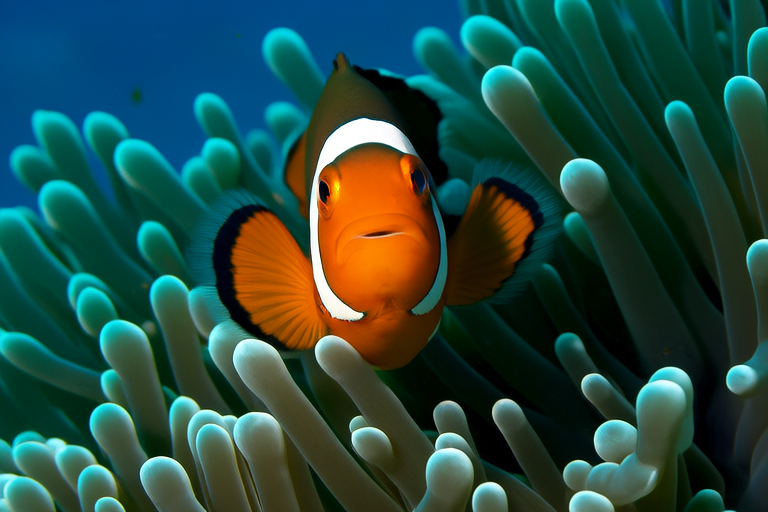
5 Fascinating Facts About Clownfish That Will Make You Fall in Love
Clownfish are among the most recognizable fish in the ocean, thanks to their vibrant colors and quirky personalities. These fish have captured the hearts of many, from children to adults, and even inspired a beloved animated movie. But beyond their charming appearance and entertaining behavior, there’s a lot more to learn about these fascinating creatures. Here are five captivating facts about clownfish that will make you fall in love with them.
Fact 1: The Unique Symbiotic Relationship with Sea Anemones
One of the most remarkable features of clownfish is their symbiotic relationship with sea anemones. This partnership is not only visually striking but also scientifically intriguing. Clownfish live among the tentacles of sea anemones, which are typically harmful to other fish due to their stinging cells called nematocysts. However, clownfish have developed a special mucus layer on their skin that protects them from the anemone’s sting. In return, the clownfish provides the anemone with food by bringing it leftovers from its meals and by attracting larger fish, which the anemone can then capture. Additionally, clownfish may help to aerate the water around the anemone and keep it clean from debris.
The relationship between clownfish and sea anemones is a prime example of mutualism, where both species benefit from each other. It’s a beautiful demonstration of nature’s balance and the complex interactions between different organisms. Watching clownfish dart in and out of the anemone’s tentacles is like witnessing a dance of trust and cooperation. This unique bond has made clownfish a symbol of marine harmony and has contributed to their popularity in aquariums and media.
Fact 2: Clownfish Are Territorial Guardians
Clownfish are fiercely territorial and protective of their homes. They spend most of their lives within a small area around the sea anemone they call home. This territory is not just a place to rest; it’s also crucial for their survival. When a clownfish is born, it joins a group of other clownfish living in a single anemone. As the clownfish grows, it competes with others in the group for dominance. Eventually, the largest and strongest fish becomes the leader, or alpha, of the group. This alpha fish is responsible for defending the anemone from potential threats.
The alpha clownfish uses its vibrant coloration and bold behavior to intimidate predators. It will swim aggressively toward any intruder, displaying its fins and making rapid movements to scare away the threat. If the predator persists, the clownfish may even attack, using its sharp teeth to bite. This behavior not only protects the anemone but also ensures the safety of the entire group. The territoriality of clownfish is a testament to their strong sense of community and their commitment to protecting their home.
Fact 3: Breeding Habits and Parental Care
Clownfish are monogamous and form long-term pair bonds with their mates. This means that once a clownfish finds a partner, they usually stay together for life. During breeding season, which typically occurs during the warmer months, the female clownfish lays hundreds or even thousands of eggs on a flat surface near the sea anemone. The male clownfish takes on the role of a dedicated father, guarding the eggs until they hatch.
The male clownfish is extremely attentive to his offspring. He fans the eggs with his fins to provide oxygen and keeps them free from debris and parasites. This parental care increases the chances of survival for the eggs and the future generation of clownfish. Once the eggs hatch, the tiny clownfish larvae drift in the open ocean for several weeks before returning to their anemone home. The entire process showcases the deep commitment and nurturing instincts of clownfish, making them truly admirable parents.
Fact 4: Adaptations for Life in the Ocean
Clownfish have several unique adaptations that allow them to thrive in their marine environment. One of the most important is their ability to change sex. All clownfish are born as males, and if the dominant female in the group dies, the largest male can transform into a female. This process, known as sequential hermaphroditism, ensures the continuity of the species and the stability of the social structure within the group.
Another adaptation is their ability to produce a mucus layer on their skin, which we mentioned earlier. This mucus not only protects them from the anemone’s sting but also helps them adjust to changes in water temperature and salinity. Clownfish also have excellent vision and can detect changes in light levels, which is crucial for navigating the complex underwater world. Their bright colors also serve as a warning to potential predators, indicating that they are toxic due to their diet of anemone tentacles.
Fact 5: Clownfish in Pop Culture and Conservation Efforts
Clownfish have become cultural icons, thanks in part to their starring role in the movie Finding Nemo. The film brought attention to the challenges faced by clownfish in the wild, including overfishing and habitat destruction. As a result, there has been increased interest in conservation efforts to protect these beloved creatures. Many organizations now focus on preserving coral reefs and sea anemones, which are essential for the survival of clownfish.
In addition to their role in movies, clownfish are also popular in home aquariums. However, it’s important to note that many clownfish in the pet trade are caught from the wild, which can harm their populations. To support conservation efforts, it’s best to choose captive-bred clownfish when setting up an aquarium. By doing so, you can enjoy the beauty and charm of these fish without contributing to their decline in the wild.
Clownfish are truly fascinating creatures with a rich array of behaviors and adaptations that make them stand out in the ocean. From their unique symbiotic relationships to their territorial instincts and parenting skills, these fish are full of surprises. By learning more about them, we can better appreciate their importance in marine ecosystems and work towards protecting them for future generations.



